My interest in shooting doesn’t stop at the 50-yard line. It begins there. I consider pistol shooting a necessary evil: a component of 3-gun competitions that I have to get through to get to the fun stuff. So when it came time for me to buy a pistol for competitions, I went for a “safe” choice: the SIG SAUER p226 9mm. Revolvers weren’t on my radar. Not for competition. Not for self-defense. Not for fun. And then, over the past year, I’ve been exposed to a number of pistols that have opened my eyes to the joys of the wheelgun. None more effectively than the Smith & Wesson Performance Center 67-5.
Aesthetically, the Smith & Wesson Model 67-5 or “Carry Comp” is a genuine classic. If you can’t see it, you never will. If you do, it only gets better with age. For me, a gun’s beauty lies in its performance. A functionally perfect machine may never find its way into an art museum, but in my world, it deserves its own gallery. So . . .
Holding the Smith & Wesson Performance Center Model 67 Carry Comp in your hands, you feel an immediate difference between Springfield’s revolver and SIG’s semi. The SIG looks danger sharp on the outside. But there’s this little wiggle in the slide reminding you that the gun was mass produced. You can shake the Smith & Wesson Performance Center 67-5 all day with nary a rattle. Everything on this gun is solid, from the Patridge sights down to the glass smooth trigger.
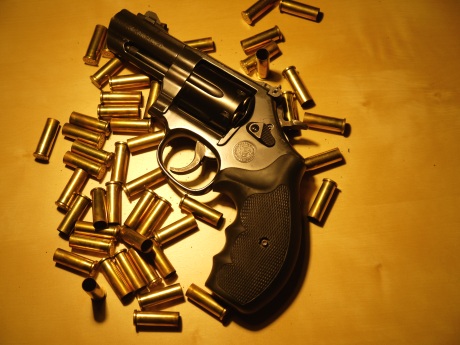
Compared to the p226, the 67-5’s sight radius is about 3/4 as long. While the Smith’s accuracy is slightly diminished, the sides of the rear sight are far sharper. The two components of the open sights are closer together; they’re almost in the same “focal plane” (the closer the two components, the sharper they are). Here’s an image illustrating the point. The Smith & Wesson Performance Center 67-5 revolver is on the left, and the SIG SAUER p226 on the right.
My trusty SIG’s been an acceptable range partner for well over a year. It’s never malfunctioned and I generally hit where I’m aiming. Much like the family minivan, I excuse its shortcomings because it does its job so well. Loaded with Sellier & Bellot .38 Special ammunition lovingly provided by our friends at LuckyGunner.com, I test fired the Smith at the NRA Headquarters Range in Fairfax, VA. The 67-5 didn’t just “do the job.” It excelled.
TheCarry Comp’s trigger accounts for much of the revolver’s stellar performance. In single action, there’s no trigger slack whatsoever. The break that follows a gentle squeeze is as clean as an OCD’s underwear drawer. In makes the SIG’s single action go-pedal feel like a two-stage trigger.
As you’d expect for a revolver marketed as a carry piece, the 67-5’s double action trigger is significantly heavier than single action operation. It’s almost twice as heavy as the SIG. Shooting the Smith accurately requires an extremely long, strong and smooth trigger pull. In this, the Smith’s ergonomics are your friend. The gun is slightly nose heavy. Better yet, the 67-5’s molded rubber grips enhance the gun’s “fit and feel” while reducing felt recoil.
To test the 67-5’s in hand accuracy, I fired four strings of 12 rounds at a target placed 20 feet away. To compare the effect on accuracy for the 67-5, I fired the first string in single action, the second in double. I used the SIG SAUER p226 as a control.
I punctured the target on the left using single action; I holed the target on the right using double action. The results are nearly identical. Unfortunately, things didn’t turn out so well for the SIG . . .
Astute readers may notice that there’s only one target. The target I perforated with the SIG in double action was too embarrassing to post.
You may have noticed that the Smith is ported. I have some ported rifles which vent to the side, but the 67-5 vents the gasses straight up. The big question: why? How many people complain about the kick of a .38? Even so, I believe the 67-5’s port helped keep the gun under control and allow for quick follow-up shots.
The top ported barrel seems to be a cause for concern amongst a number of other reviewers. One reviewer believed that the 12 o’ clock port would cause some nasty burns to the shooter if they were in a close quarters situation, holding the gun at their side. I’m more inclined to believe the cylinder gap would be more of an issue in that situation (and really can’t fathom how a top ported barrel could injure someone’s side any more than a normal muzzle blast).
In addition, some gun gurus question whether the top port means that more of the flash will be in the shooter’s line of sight, damaging their night vision. Keep an eye out for an upcoming experiment testing this hypothesis. So to speak.
The model 67-5’s solid stainless steel construction also minimizes recoil. When empty, the Smith & Wesson .38 weighs 25 ounces. That’s more than the SIG P226 with a full magazine. The revolver’s just as long and tall as my semi. With practically identical weights and dimensions (even the bullets weigh the same), the comparo presents us with an interesting choice: carry the SIG with three times as many rounds as the .38 Special, or . . . what? Reliability?
For me, that’s the Model 67-5’s fundamental flaw: it’s a revolver. Revolvers have never liked me; a Mateba took a chunk out of my thumb thanks to a six o’ clock chamber position and some poor thumb placement. Getting a good grip on something that vents gases all over the place is hard for someone with big hands like me.
Having a break in the barrel seems like lazy design work in this day and age. In a world where the Nagant 1895 revolver is in existence, there’s no need for the cylinder gap to keep appearing in designs (the Nagant’s cylinder actually moves forward to close the gap before firing).
Revolvers are practically useless in competitions. They’re hard to reload and offer limited capacity. The Smith & Wesson’s double action pull is also extremely heavy. I can happily shoot my Sig p226 in double action all day long. Shooting the 67-5, I became thankful that the cylinder only holds six rounds, allowing my trigger finger some much need R&R.
At this point, I feel obligated to report that there’ve been some reports of Model 67s with less than 800 rounds lunching their barrels dowrange. Then again, the Internet’s a generally dangerous place for reliability-focused buyers. I’ve seen similar reports about Glocks and even 1911s. Fortunately, S&W offers a lifetime warranty on all its guns—provided you’re alive to use it.
In the end, the 67-5 is a fantastic range gun. It’s a hoot to shoot. It’s more accurate than I will ever be (with a handgun). It oozes class and evokes images of detective stories. I wouldn’t begrudge someone carrying one, especially compared to a hard-to-control flyweight snubbie. But there’s a reason semis have elbowed aside wheelguns. In this case, it has nothing to do with accuracy or style. ‘Nuff said?
Specifications
caliber – .38 Special
height – 5.6″
length – 8.3″
width – 1.41″
weight -38 oz.
magazine capacity – 6 rounds
3” top ported barrel
Street price – around $700.00
Ratings (out of five)
Style * * * * *
I mean, just LOOK at that thing!
Ergonomics * * *
The grip is comfortable in the dominant hand, but where is the support hand supposed to go?
Ergonomics Firing * * *
Hand position issues coupled with a painful hammer brought the score WAY down.
Reliability * * * * *
It’s a revolver. Unless it’s completely rusted out it’s good to go.
Customize this *
There’s nothing left to do. The gun comes pimped out from the factory, and I haven’t been able to find a single website offering aftermarket modifications. S&W does, however, offer gunsmithing services for Performance Center firearms . . . for a fee.
Overall Rating * * * *
It’s a great gun for the range, but taking into consideration home defense and concealed carry scenarios I think I’d prefer something that isn’t a revolver.
All images courtesy of Nick Leghorn for TTAG


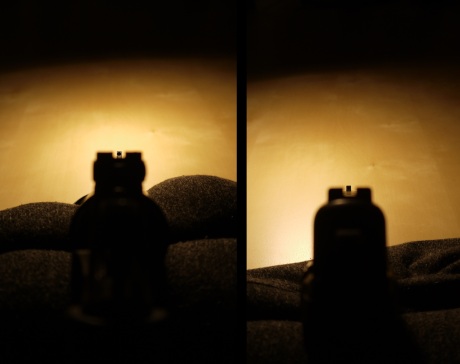



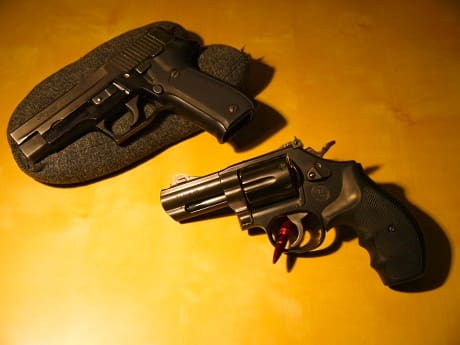
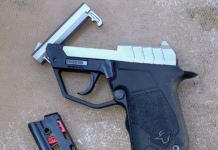
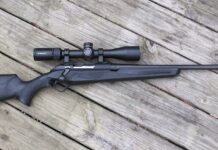
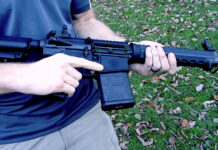
The Nagant 1895 is an interesting piece of work. It is the only revolver that can be effectively suppressed. The downside to that it is the only revolver that can jam (aside from a squib in the cylinder and barrel).
Oooooo, Nick, that’s a handsome revolver and a great review. For personal defense, I agree that it wouldn’t be my first choice. However, the S&W 686+ in .357 would be a great choice. I don’t believe that there’s ever been a finer SD round than the .357Mag, and the 686+ holds seven of ’em.
Nice review Nick. Sure is a good looking revolver. I’m with you on the support hand thing. I like a revolver as much as the next guy, but where the hell is my left hand supposed to go? I actually just sold a small frame revolver for that very reason. I could not find an effective or comfortable place to put my hand.
Ryan, et al.
Firing a revolver does require a somewhat different hold on the weapon due to the grip shape and the lack of flat surface areas found on bottom feeders. I started out using wheelguns and shooting PPC courses. It was only later, in my mid-thirties I learned to enjoy shooting pistols as well as revolvers.
Too, there’s a different mindset for sixgun shooters. With a revolver’s limited capacity, you make each shot count as much as you can. Speed is fine, accuracy is final (Bill Jordan, USBP). A revolver shooter relies on accuracy rather than volume. If one were carrying the Model 67 today during a confrontation there are still very good odds the revolver shooter would prevail. Some of that has to do with how you train and your defensive mindset.
Just one example. In a confrontation, this old smoke pole shooter will fire a double-tap, then scurry like a frightened crab towards the nearest cover. Standing inside an 8-ft circle of my initial shots is recipe for disaster. I will conserve my ammo, seek cover, and defend against his follow-up against me, if any. Unlike the reckless street thugs, each round we fire has a prosecutor and a civil lawyer attached to it. The general rule of thumb we were taught was that if you don’t make contact with one of the first four shots, you’re doing it wrong. Breathe, focus on the front sight and concentrate on hitting the target. I like pistols, but more ammo doesn’t help if you don’t make hits. You just can’t miss fast enough to win a gunfight.
S&W…please get rid of the lock so I can give you some of my $$$$$.
This design made better sense when they attached the Carry Comp barrel to a Model 19 or 66. Alas, S&W doesn’t want to sell K-Frame .357 Magnums anymore.
Sorry, Lance, with all respect,the nagant’s not the sole revolver that can be suppressed. During the Cold War a batch of specially modified revolvers, by Sionics I believe, were made for the “West German Border Guards”-supposedly. My actual guess was cross -border black ops. Think why-no chance of casings left behind. Trust me, they were done-with a special shroud over to encompass the cylinder gap leak and cylinder. Also, I’ve personally experienced jamming of revolvers with too tight of a cylinder gap-one colt and two taurus 905’s. The quick fix is CAREFULLY and lightly filing the forcing cone. I’ve actually spoken to Taurus on the phone about it-to what effect I know not.
Self defense with a revolver? Damn skippy! Many friends call me Two Gun Mike as more often than not, I carry two snubbies and a pocket of speedloaders. My fave is .38 special +P+’s and Magsafe rounds. Sure, I have MANY semiauto pistols, but especially in hot weather, the snubbies pocket well! I just believe in practice: slow fire with sights, quickfire with sight reference and rapid fire point/instinct shooting. Then again, I also like to shoot skeet with riot shotguns! Maybe the VA ”shrink” was right………
Where is your left hand supposed to go? The question doesn’t even make sense. It’s as simple to grip a revolver as it is a semi-auto. The fatal flaw of this revolver is that a Mataeba once took a chunk out of your thumb? This doesn’t seem like much of a flaw to me.
And revolvers are not at all useless in competition (well, 3 gun maybe). As a USPSA shooter you must have seen a few shooters with Model 625s. I don’t even shoot USPSA but I know several people who do and exclusively with revolvers. Moon clips make reloads pretty easy (I know that’s not what you’re talking about here) and speed loaders are not really that hard. Comp IIs or IIIs, not something like the HKS.
I think if you had this revolver’s trigger worked on by someone who knows what they’re doing your opinion of it would change. If I owned one I would have the hammer bobbed so it could only be fired DA.
Great review. I came to this page while doing a search for the Smith & Wesson 67 and had no idea there was a Performance Center model. At listing price of $700 new, I think it is worth every dollar. The 67 has always had great balance and feel. My only suggestion on this review is that I wish the pictures were better lighted. The gun looks really dark in your photos and hard to see any of the fine details you mention.
The Model 67 is the stainless steel version of the Model 15 K-38 Combat Masterpiece. Both guns are .38 Special revolvers with a tapered 4-inch barrel with an integral sight rib on the top of the barrel and frame, Baughman ramp front sights, S&W adjustable rear sights, six round capacity. A few Model 15’s were made late in it’s life with 6-inch barrels (typically the 6-inch version was the Model 14 which also served as a target revolver).
These are perhaps some of the best balanced revolvers you can put in your hand. And they have a certain graceful eye appeal too. Later models lack the taper at the base of the barrel, substituting a slightly heavier barrel (and it’s easier to produce).
The K-series of the 1950’s included the K-22 (Model 17) .22 rimfire with a six-inch barrel, the K-32 (Model 16) in .32 S&W Long, 6-inch and the K-38 (Model 14) .38 Special with a 6-inch barrel. S&W promoted these to police agencies and shooting clubs as being nearly identical in their size and handling for training shooters. The 4-inch K-38 (Model 15) was the choice of many city police departments while Sheriffs in rural areas used the longer Model 14.
The Model 15/67 makes a dandy home defense gun loaded with modern +P JHP ammunition.
You won’t find a S&W Performance Center revolver for $700.00 on this planet or any other I know of. I have a model#67, 4-1/4 inch barrel and it cost me $700,00 in 2013 new , plus tax and other CA fees. $800.00 out the door and this baby is near indestructible 38 oz unloaded. The comment referring to accuracy is correct. Six rounds is sufficient in a gun fight that is usually five to ten feet in distance. I carry the Glaser Safety Slug Blue. Any other round in close quarters could leave collateral damage. You don’t want to kill your neighbor or do you?
Comments are closed.